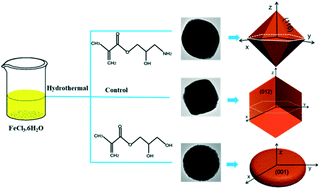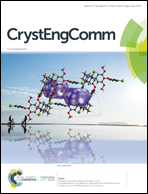Hematite mesocrystals templated by hydrolyzed and aminolyzed glycidyl methacrylate, and their application in photocatalytic Fenton reaction†
Abstract
As an n-type semiconductor with a band gap of 1.9–2.2 eV, α-Fe2O3 is widely applied for photo-electrodes, organic pollutant degradation, ion adsorption, gas sensors, etc. Therefore, controlled synthesis of hematite with certain morphology has attracted increasing attention due to the unique properties associated with a specific crystal face. Here, we present a simple hydrothermal method to prepare hematite mesocrystals with novel morphologies. Substituted vicinal diol and alkamine were generated via hydrolysis and aminolysis of glycidyl methacrylate and used as novel capping agents to obtain plate-like and hexagonal bipyramidal mesocrystals, respectively. The effects of capping agents on morphology were investigated and the formation mechanism was discussed. The mainly exposed faces of the plate-like and bipyramid-like mesocrystals were the {001} and {116} planes, respectively. Improvement in the catalytic activity for the photo-Fenton reaction was achieved probably due to the specific exposed crystal faces.



 Please wait while we load your content...
Please wait while we load your content...